Detailed Analysis of Target's Failure in the Retail Industry
VerifiedAdded on 2023/01/17
|10
|2129
|85
Report
AI Summary
This report provides a detailed analysis of Target Corporation's failure in the Canadian retail market. It begins with an executive summary and introduction to Target, followed by a discussion of the company's internal environment using a SWOT analysis, highlighting strengths such as its strong US presence and product differentiation, but also weaknesses like customer data breaches and supplier dependence. Opportunities include expansion and online market growth, while threats involve competition and increasing e-commerce. The report then delves into the specific reasons for Target's failure in Canada, including unmet customer expectations, pricing discrepancies, unsatisfactory shopping experiences, and a lack of product selection. The analysis concludes by emphasizing the importance of understanding customer needs and perceptions, and recommends improvements in customer analysis, pricing strategies, employee training, and distribution systems. The report provides a comprehensive overview of the factors contributing to Target's downfall in Canada's retail landscape.
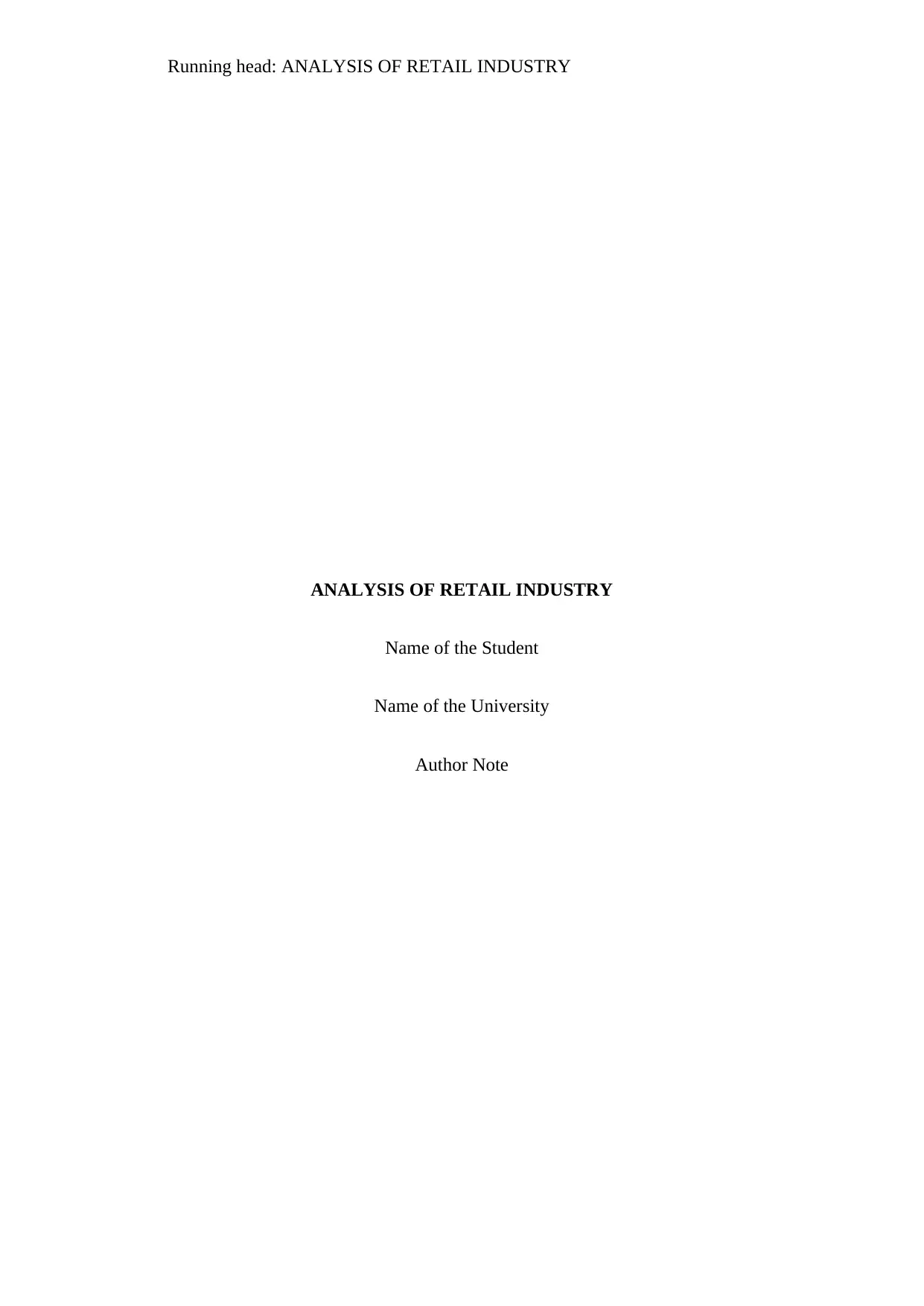
Running head: ANALYSIS OF RETAIL INDUSTRY
ANALYSIS OF RETAIL INDUSTRY
Name of the Student
Name of the University
Author Note
ANALYSIS OF RETAIL INDUSTRY
Name of the Student
Name of the University
Author Note
Paraphrase This Document
Need a fresh take? Get an instant paraphrase of this document with our AI Paraphraser
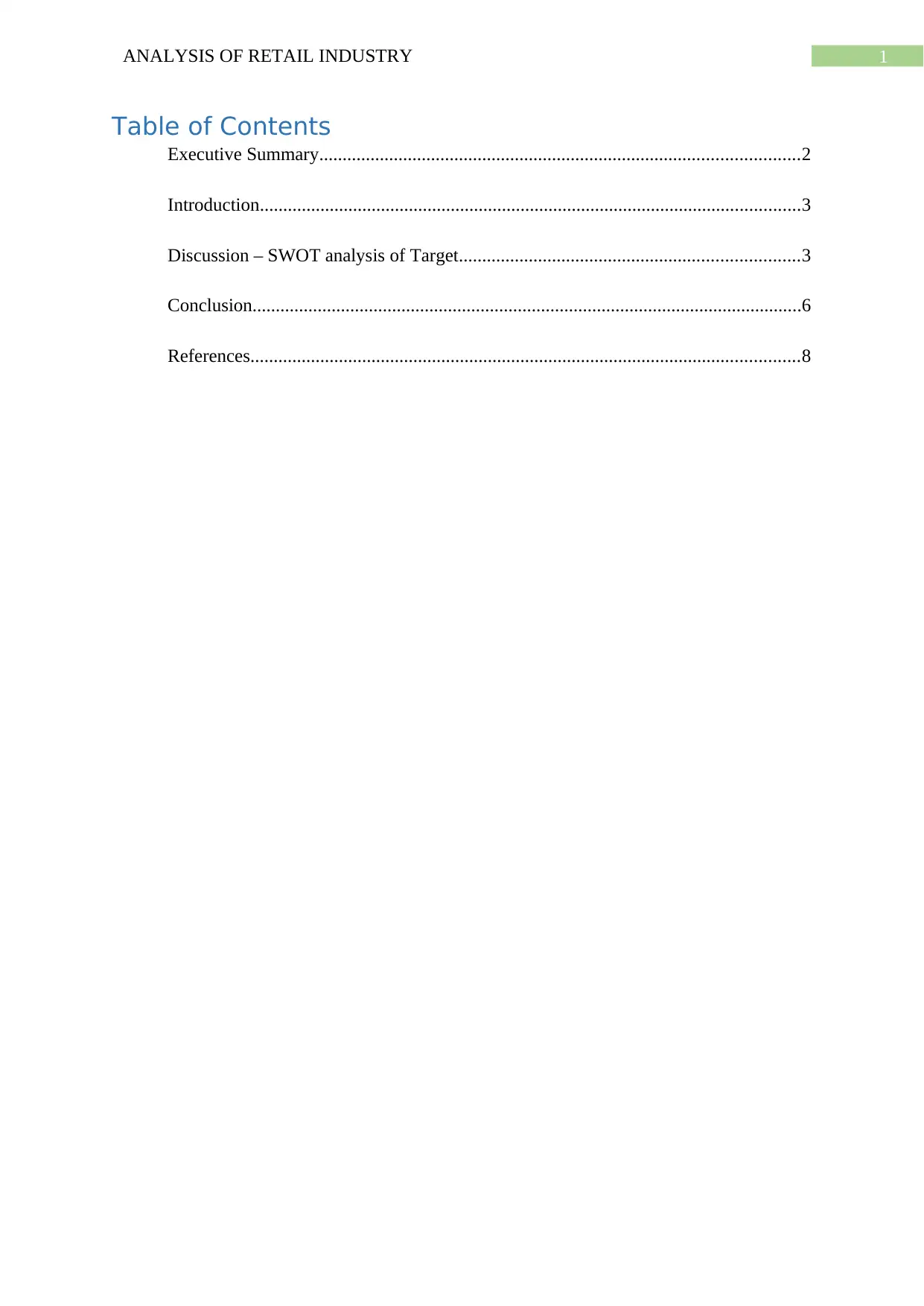
1ANALYSIS OF RETAIL INDUSTRY
Table of Contents
Executive Summary.......................................................................................................2
Introduction....................................................................................................................3
Discussion – SWOT analysis of Target.........................................................................3
Conclusion......................................................................................................................6
References......................................................................................................................8
Table of Contents
Executive Summary.......................................................................................................2
Introduction....................................................................................................................3
Discussion – SWOT analysis of Target.........................................................................3
Conclusion......................................................................................................................6
References......................................................................................................................8
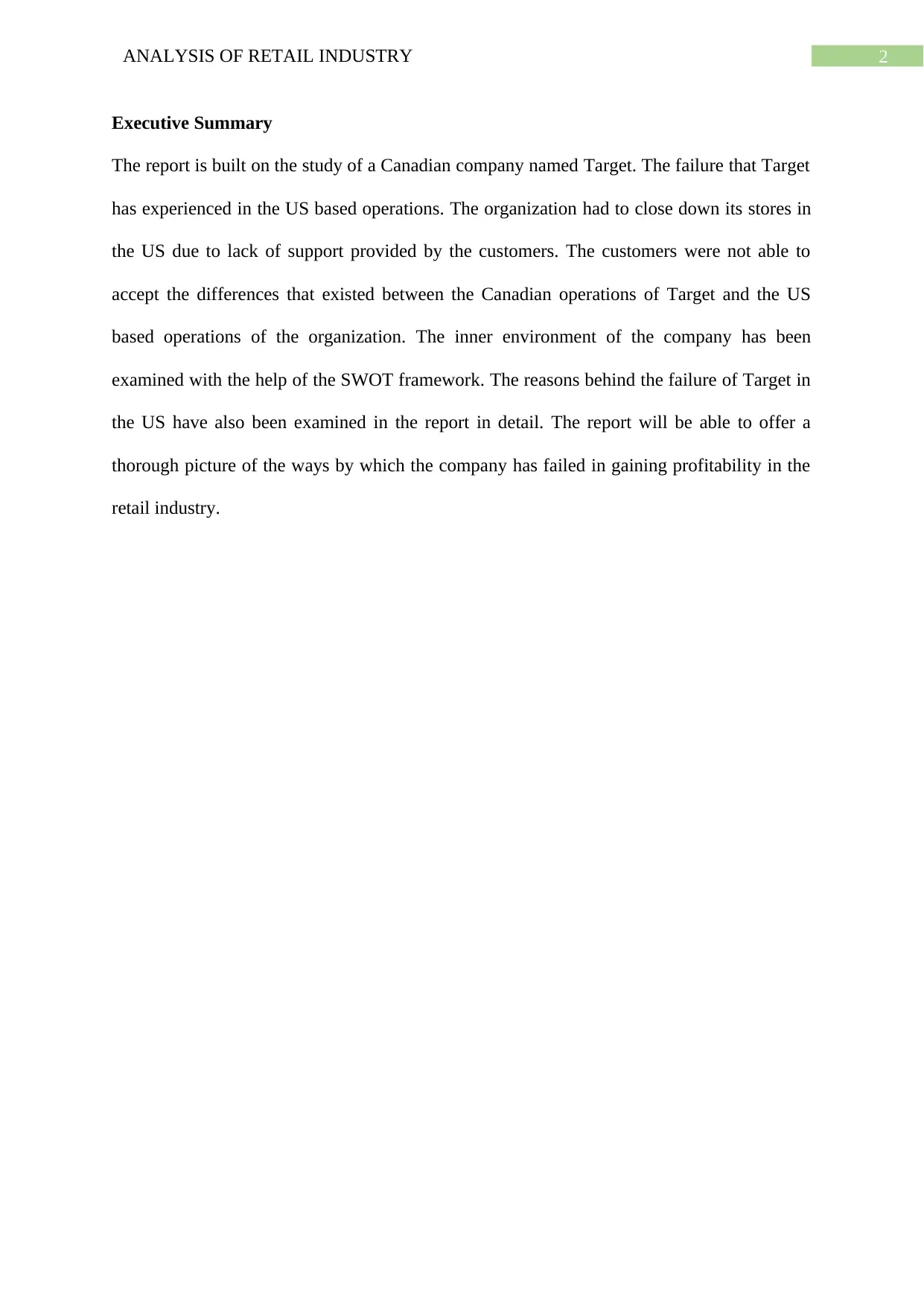
2ANALYSIS OF RETAIL INDUSTRY
Executive Summary
The report is built on the study of a Canadian company named Target. The failure that Target
has experienced in the US based operations. The organization had to close down its stores in
the US due to lack of support provided by the customers. The customers were not able to
accept the differences that existed between the Canadian operations of Target and the US
based operations of the organization. The inner environment of the company has been
examined with the help of the SWOT framework. The reasons behind the failure of Target in
the US have also been examined in the report in detail. The report will be able to offer a
thorough picture of the ways by which the company has failed in gaining profitability in the
retail industry.
Executive Summary
The report is built on the study of a Canadian company named Target. The failure that Target
has experienced in the US based operations. The organization had to close down its stores in
the US due to lack of support provided by the customers. The customers were not able to
accept the differences that existed between the Canadian operations of Target and the US
based operations of the organization. The inner environment of the company has been
examined with the help of the SWOT framework. The reasons behind the failure of Target in
the US have also been examined in the report in detail. The report will be able to offer a
thorough picture of the ways by which the company has failed in gaining profitability in the
retail industry.
⊘ This is a preview!⊘
Do you want full access?
Subscribe today to unlock all pages.

Trusted by 1+ million students worldwide

3ANALYSIS OF RETAIL INDUSTRY
Introduction
Target Corporation is eight biggest organizations in the retail industry of the US. The
organization was established by George Dayton and its headquarters are located in
Minneapolis. The organization was originally named as Goodfellow Dry Goods in the year
1902 and was renamed as Dayton’s Dry Goods Company in the year 1910. First store of
Target was opened in Roseville, Minnesota in 1962. Target has been able to establish itself as
the highest earning based division in Dayton Hudson Corporation (Target.com, 2019).
The report will be based on the issues that have been faced by Target in Canada and
the reasons that had led to its failure in the country. The internal environment based factors of
Target that had an influence on the processes of the business will also be discussed in the
report on detail.
Discussion – SWOT analysis of Target
SWOT analysis
Strengths – Target Corporation has been successful in developing a strong presence
in the US and the company operates on a large scale in the country in order to enforce the low
prices. Target has been successful in developing differentiation in the industry with the help
of products and services which are presented to the customers. Differentiation has been a
major focus for the organization in order to continue its effective processes (Daspit et al.,
2017). The pricing based strategy is built on the trends in the industry. The positioning of
price is built on the variations that have taken place in the external environment. The loyalty
based programs that are implemented by Target have played a key part in the development a
huge customer base in the industry (Demir, Wennberg & McKelvie, 2017).
Weaknesses – The breach of customer data that has been experienced by Target
recently has a major impact on the reputation of the organization. The leak of confidential
Introduction
Target Corporation is eight biggest organizations in the retail industry of the US. The
organization was established by George Dayton and its headquarters are located in
Minneapolis. The organization was originally named as Goodfellow Dry Goods in the year
1902 and was renamed as Dayton’s Dry Goods Company in the year 1910. First store of
Target was opened in Roseville, Minnesota in 1962. Target has been able to establish itself as
the highest earning based division in Dayton Hudson Corporation (Target.com, 2019).
The report will be based on the issues that have been faced by Target in Canada and
the reasons that had led to its failure in the country. The internal environment based factors of
Target that had an influence on the processes of the business will also be discussed in the
report on detail.
Discussion – SWOT analysis of Target
SWOT analysis
Strengths – Target Corporation has been successful in developing a strong presence
in the US and the company operates on a large scale in the country in order to enforce the low
prices. Target has been successful in developing differentiation in the industry with the help
of products and services which are presented to the customers. Differentiation has been a
major focus for the organization in order to continue its effective processes (Daspit et al.,
2017). The pricing based strategy is built on the trends in the industry. The positioning of
price is built on the variations that have taken place in the external environment. The loyalty
based programs that are implemented by Target have played a key part in the development a
huge customer base in the industry (Demir, Wennberg & McKelvie, 2017).
Weaknesses – The breach of customer data that has been experienced by Target
recently has a major impact on the reputation of the organization. The leak of confidential
Paraphrase This Document
Need a fresh take? Get an instant paraphrase of this document with our AI Paraphraser
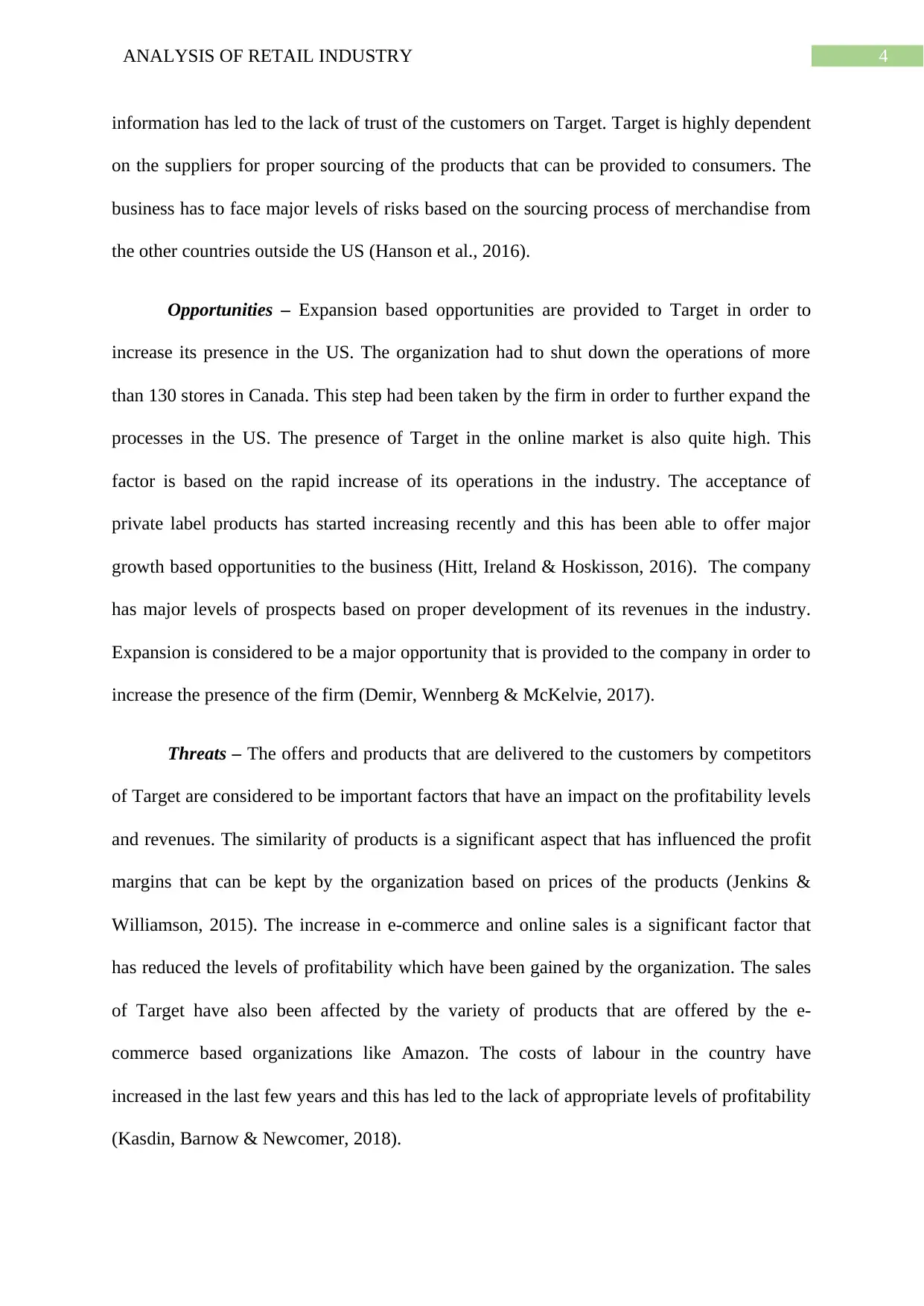
4ANALYSIS OF RETAIL INDUSTRY
information has led to the lack of trust of the customers on Target. Target is highly dependent
on the suppliers for proper sourcing of the products that can be provided to consumers. The
business has to face major levels of risks based on the sourcing process of merchandise from
the other countries outside the US (Hanson et al., 2016).
Opportunities – Expansion based opportunities are provided to Target in order to
increase its presence in the US. The organization had to shut down the operations of more
than 130 stores in Canada. This step had been taken by the firm in order to further expand the
processes in the US. The presence of Target in the online market is also quite high. This
factor is based on the rapid increase of its operations in the industry. The acceptance of
private label products has started increasing recently and this has been able to offer major
growth based opportunities to the business (Hitt, Ireland & Hoskisson, 2016). The company
has major levels of prospects based on proper development of its revenues in the industry.
Expansion is considered to be a major opportunity that is provided to the company in order to
increase the presence of the firm (Demir, Wennberg & McKelvie, 2017).
Threats – The offers and products that are delivered to the customers by competitors
of Target are considered to be important factors that have an impact on the profitability levels
and revenues. The similarity of products is a significant aspect that has influenced the profit
margins that can be kept by the organization based on prices of the products (Jenkins &
Williamson, 2015). The increase in e-commerce and online sales is a significant factor that
has reduced the levels of profitability which have been gained by the organization. The sales
of Target have also been affected by the variety of products that are offered by the e-
commerce based organizations like Amazon. The costs of labour in the country have
increased in the last few years and this has led to the lack of appropriate levels of profitability
(Kasdin, Barnow & Newcomer, 2018).
information has led to the lack of trust of the customers on Target. Target is highly dependent
on the suppliers for proper sourcing of the products that can be provided to consumers. The
business has to face major levels of risks based on the sourcing process of merchandise from
the other countries outside the US (Hanson et al., 2016).
Opportunities – Expansion based opportunities are provided to Target in order to
increase its presence in the US. The organization had to shut down the operations of more
than 130 stores in Canada. This step had been taken by the firm in order to further expand the
processes in the US. The presence of Target in the online market is also quite high. This
factor is based on the rapid increase of its operations in the industry. The acceptance of
private label products has started increasing recently and this has been able to offer major
growth based opportunities to the business (Hitt, Ireland & Hoskisson, 2016). The company
has major levels of prospects based on proper development of its revenues in the industry.
Expansion is considered to be a major opportunity that is provided to the company in order to
increase the presence of the firm (Demir, Wennberg & McKelvie, 2017).
Threats – The offers and products that are delivered to the customers by competitors
of Target are considered to be important factors that have an impact on the profitability levels
and revenues. The similarity of products is a significant aspect that has influenced the profit
margins that can be kept by the organization based on prices of the products (Jenkins &
Williamson, 2015). The increase in e-commerce and online sales is a significant factor that
has reduced the levels of profitability which have been gained by the organization. The sales
of Target have also been affected by the variety of products that are offered by the e-
commerce based organizations like Amazon. The costs of labour in the country have
increased in the last few years and this has led to the lack of appropriate levels of profitability
(Kasdin, Barnow & Newcomer, 2018).
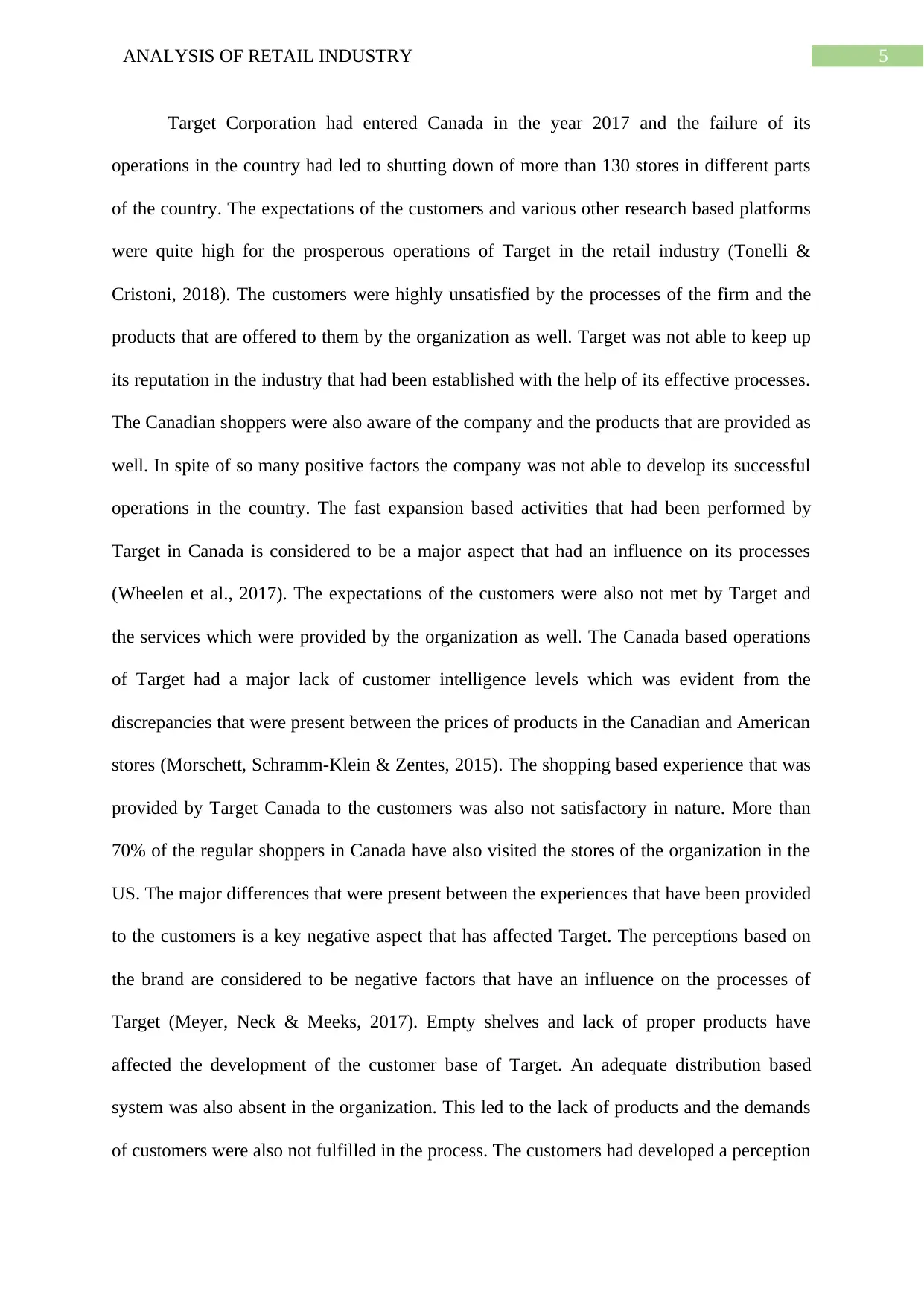
5ANALYSIS OF RETAIL INDUSTRY
Target Corporation had entered Canada in the year 2017 and the failure of its
operations in the country had led to shutting down of more than 130 stores in different parts
of the country. The expectations of the customers and various other research based platforms
were quite high for the prosperous operations of Target in the retail industry (Tonelli &
Cristoni, 2018). The customers were highly unsatisfied by the processes of the firm and the
products that are offered to them by the organization as well. Target was not able to keep up
its reputation in the industry that had been established with the help of its effective processes.
The Canadian shoppers were also aware of the company and the products that are provided as
well. In spite of so many positive factors the company was not able to develop its successful
operations in the country. The fast expansion based activities that had been performed by
Target in Canada is considered to be a major aspect that had an influence on its processes
(Wheelen et al., 2017). The expectations of the customers were also not met by Target and
the services which were provided by the organization as well. The Canada based operations
of Target had a major lack of customer intelligence levels which was evident from the
discrepancies that were present between the prices of products in the Canadian and American
stores (Morschett, Schramm-Klein & Zentes, 2015). The shopping based experience that was
provided by Target Canada to the customers was also not satisfactory in nature. More than
70% of the regular shoppers in Canada have also visited the stores of the organization in the
US. The major differences that were present between the experiences that have been provided
to the customers is a key negative aspect that has affected Target. The perceptions based on
the brand are considered to be negative factors that have an influence on the processes of
Target (Meyer, Neck & Meeks, 2017). Empty shelves and lack of proper products have
affected the development of the customer base of Target. An adequate distribution based
system was also absent in the organization. This led to the lack of products and the demands
of customers were also not fulfilled in the process. The customers had developed a perception
Target Corporation had entered Canada in the year 2017 and the failure of its
operations in the country had led to shutting down of more than 130 stores in different parts
of the country. The expectations of the customers and various other research based platforms
were quite high for the prosperous operations of Target in the retail industry (Tonelli &
Cristoni, 2018). The customers were highly unsatisfied by the processes of the firm and the
products that are offered to them by the organization as well. Target was not able to keep up
its reputation in the industry that had been established with the help of its effective processes.
The Canadian shoppers were also aware of the company and the products that are provided as
well. In spite of so many positive factors the company was not able to develop its successful
operations in the country. The fast expansion based activities that had been performed by
Target in Canada is considered to be a major aspect that had an influence on its processes
(Wheelen et al., 2017). The expectations of the customers were also not met by Target and
the services which were provided by the organization as well. The Canada based operations
of Target had a major lack of customer intelligence levels which was evident from the
discrepancies that were present between the prices of products in the Canadian and American
stores (Morschett, Schramm-Klein & Zentes, 2015). The shopping based experience that was
provided by Target Canada to the customers was also not satisfactory in nature. More than
70% of the regular shoppers in Canada have also visited the stores of the organization in the
US. The major differences that were present between the experiences that have been provided
to the customers is a key negative aspect that has affected Target. The perceptions based on
the brand are considered to be negative factors that have an influence on the processes of
Target (Meyer, Neck & Meeks, 2017). Empty shelves and lack of proper products have
affected the development of the customer base of Target. An adequate distribution based
system was also absent in the organization. This led to the lack of products and the demands
of customers were also not fulfilled in the process. The customers had developed a perception
⊘ This is a preview!⊘
Do you want full access?
Subscribe today to unlock all pages.

Trusted by 1+ million students worldwide
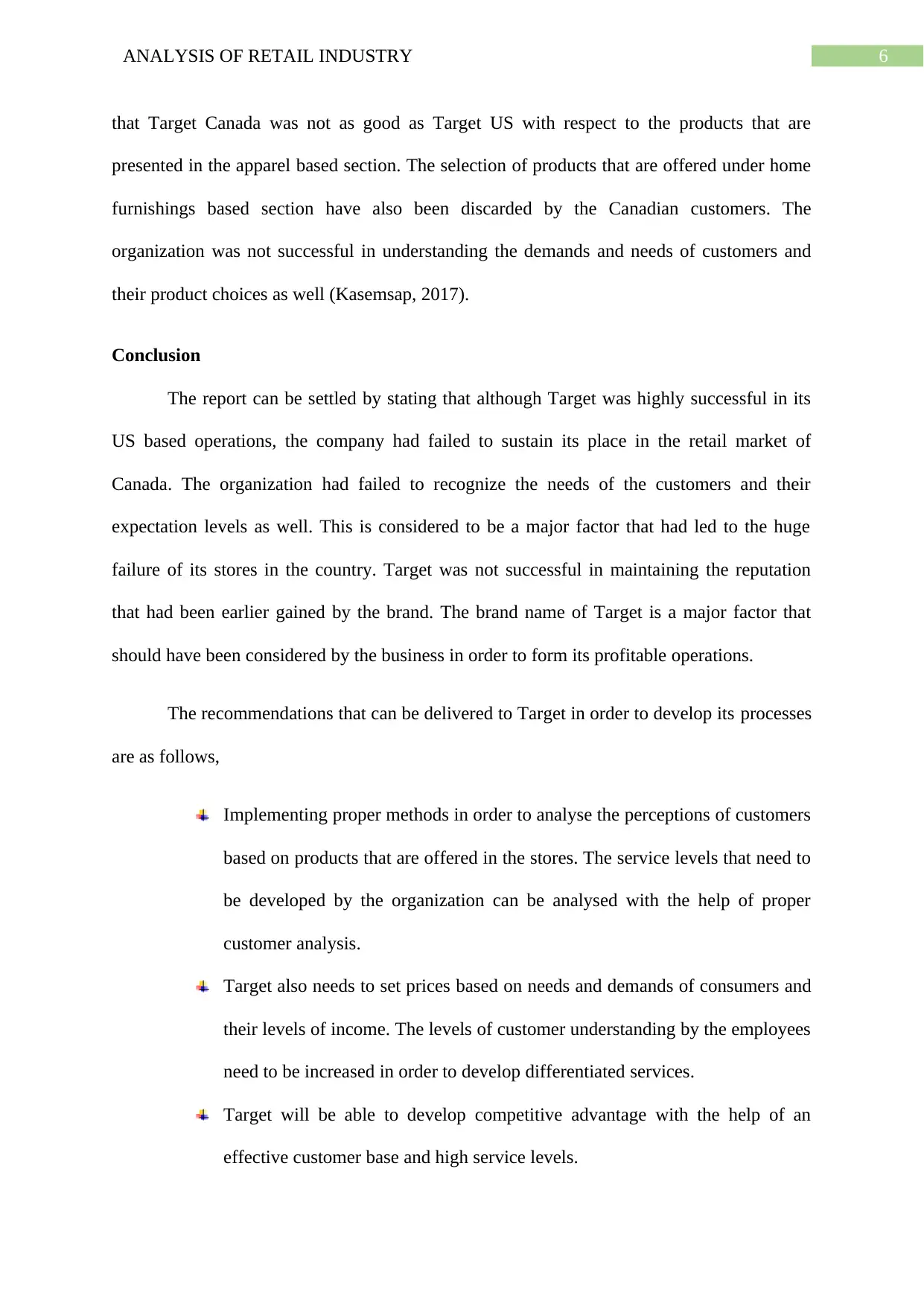
6ANALYSIS OF RETAIL INDUSTRY
that Target Canada was not as good as Target US with respect to the products that are
presented in the apparel based section. The selection of products that are offered under home
furnishings based section have also been discarded by the Canadian customers. The
organization was not successful in understanding the demands and needs of customers and
their product choices as well (Kasemsap, 2017).
Conclusion
The report can be settled by stating that although Target was highly successful in its
US based operations, the company had failed to sustain its place in the retail market of
Canada. The organization had failed to recognize the needs of the customers and their
expectation levels as well. This is considered to be a major factor that had led to the huge
failure of its stores in the country. Target was not successful in maintaining the reputation
that had been earlier gained by the brand. The brand name of Target is a major factor that
should have been considered by the business in order to form its profitable operations.
The recommendations that can be delivered to Target in order to develop its processes
are as follows,
Implementing proper methods in order to analyse the perceptions of customers
based on products that are offered in the stores. The service levels that need to
be developed by the organization can be analysed with the help of proper
customer analysis.
Target also needs to set prices based on needs and demands of consumers and
their levels of income. The levels of customer understanding by the employees
need to be increased in order to develop differentiated services.
Target will be able to develop competitive advantage with the help of an
effective customer base and high service levels.
that Target Canada was not as good as Target US with respect to the products that are
presented in the apparel based section. The selection of products that are offered under home
furnishings based section have also been discarded by the Canadian customers. The
organization was not successful in understanding the demands and needs of customers and
their product choices as well (Kasemsap, 2017).
Conclusion
The report can be settled by stating that although Target was highly successful in its
US based operations, the company had failed to sustain its place in the retail market of
Canada. The organization had failed to recognize the needs of the customers and their
expectation levels as well. This is considered to be a major factor that had led to the huge
failure of its stores in the country. Target was not successful in maintaining the reputation
that had been earlier gained by the brand. The brand name of Target is a major factor that
should have been considered by the business in order to form its profitable operations.
The recommendations that can be delivered to Target in order to develop its processes
are as follows,
Implementing proper methods in order to analyse the perceptions of customers
based on products that are offered in the stores. The service levels that need to
be developed by the organization can be analysed with the help of proper
customer analysis.
Target also needs to set prices based on needs and demands of consumers and
their levels of income. The levels of customer understanding by the employees
need to be increased in order to develop differentiated services.
Target will be able to develop competitive advantage with the help of an
effective customer base and high service levels.
Paraphrase This Document
Need a fresh take? Get an instant paraphrase of this document with our AI Paraphraser
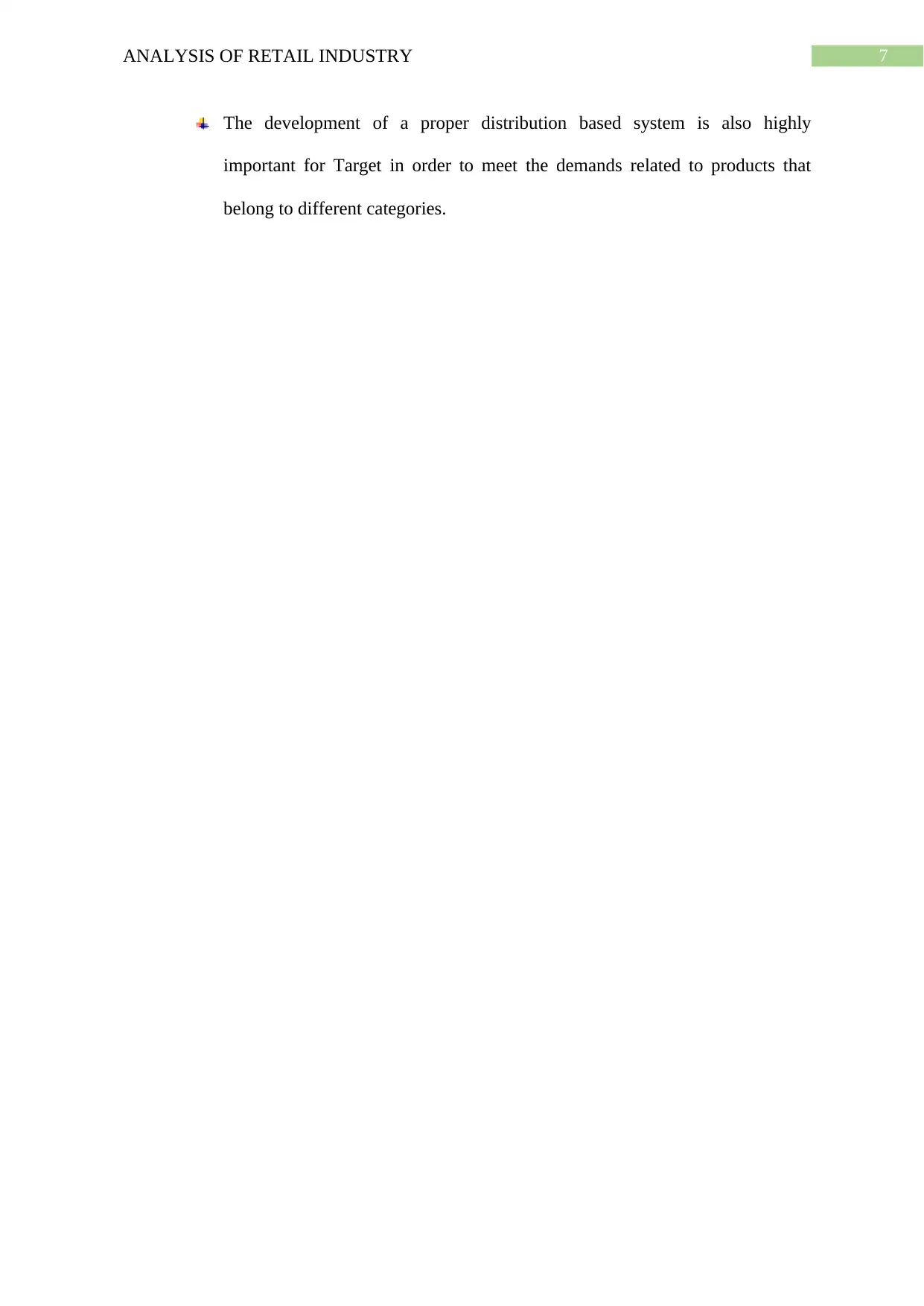
7ANALYSIS OF RETAIL INDUSTRY
The development of a proper distribution based system is also highly
important for Target in order to meet the demands related to products that
belong to different categories.
The development of a proper distribution based system is also highly
important for Target in order to meet the demands related to products that
belong to different categories.
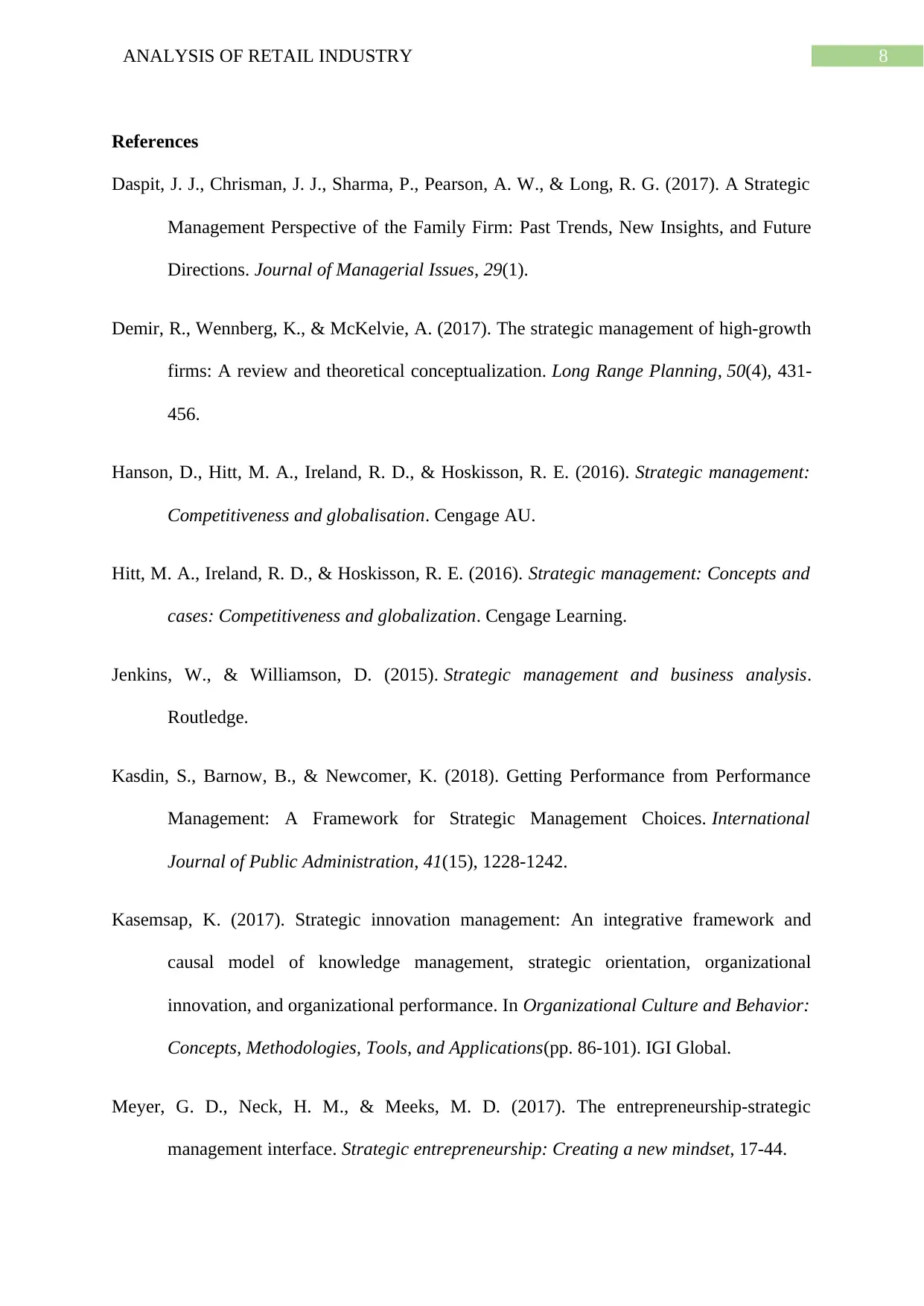
8ANALYSIS OF RETAIL INDUSTRY
References
Daspit, J. J., Chrisman, J. J., Sharma, P., Pearson, A. W., & Long, R. G. (2017). A Strategic
Management Perspective of the Family Firm: Past Trends, New Insights, and Future
Directions. Journal of Managerial Issues, 29(1).
Demir, R., Wennberg, K., & McKelvie, A. (2017). The strategic management of high-growth
firms: A review and theoretical conceptualization. Long Range Planning, 50(4), 431-
456.
Hanson, D., Hitt, M. A., Ireland, R. D., & Hoskisson, R. E. (2016). Strategic management:
Competitiveness and globalisation. Cengage AU.
Hitt, M. A., Ireland, R. D., & Hoskisson, R. E. (2016). Strategic management: Concepts and
cases: Competitiveness and globalization. Cengage Learning.
Jenkins, W., & Williamson, D. (2015). Strategic management and business analysis.
Routledge.
Kasdin, S., Barnow, B., & Newcomer, K. (2018). Getting Performance from Performance
Management: A Framework for Strategic Management Choices. International
Journal of Public Administration, 41(15), 1228-1242.
Kasemsap, K. (2017). Strategic innovation management: An integrative framework and
causal model of knowledge management, strategic orientation, organizational
innovation, and organizational performance. In Organizational Culture and Behavior:
Concepts, Methodologies, Tools, and Applications(pp. 86-101). IGI Global.
Meyer, G. D., Neck, H. M., & Meeks, M. D. (2017). The entrepreneurship‐strategic
management interface. Strategic entrepreneurship: Creating a new mindset, 17-44.
References
Daspit, J. J., Chrisman, J. J., Sharma, P., Pearson, A. W., & Long, R. G. (2017). A Strategic
Management Perspective of the Family Firm: Past Trends, New Insights, and Future
Directions. Journal of Managerial Issues, 29(1).
Demir, R., Wennberg, K., & McKelvie, A. (2017). The strategic management of high-growth
firms: A review and theoretical conceptualization. Long Range Planning, 50(4), 431-
456.
Hanson, D., Hitt, M. A., Ireland, R. D., & Hoskisson, R. E. (2016). Strategic management:
Competitiveness and globalisation. Cengage AU.
Hitt, M. A., Ireland, R. D., & Hoskisson, R. E. (2016). Strategic management: Concepts and
cases: Competitiveness and globalization. Cengage Learning.
Jenkins, W., & Williamson, D. (2015). Strategic management and business analysis.
Routledge.
Kasdin, S., Barnow, B., & Newcomer, K. (2018). Getting Performance from Performance
Management: A Framework for Strategic Management Choices. International
Journal of Public Administration, 41(15), 1228-1242.
Kasemsap, K. (2017). Strategic innovation management: An integrative framework and
causal model of knowledge management, strategic orientation, organizational
innovation, and organizational performance. In Organizational Culture and Behavior:
Concepts, Methodologies, Tools, and Applications(pp. 86-101). IGI Global.
Meyer, G. D., Neck, H. M., & Meeks, M. D. (2017). The entrepreneurship‐strategic
management interface. Strategic entrepreneurship: Creating a new mindset, 17-44.
⊘ This is a preview!⊘
Do you want full access?
Subscribe today to unlock all pages.

Trusted by 1+ million students worldwide
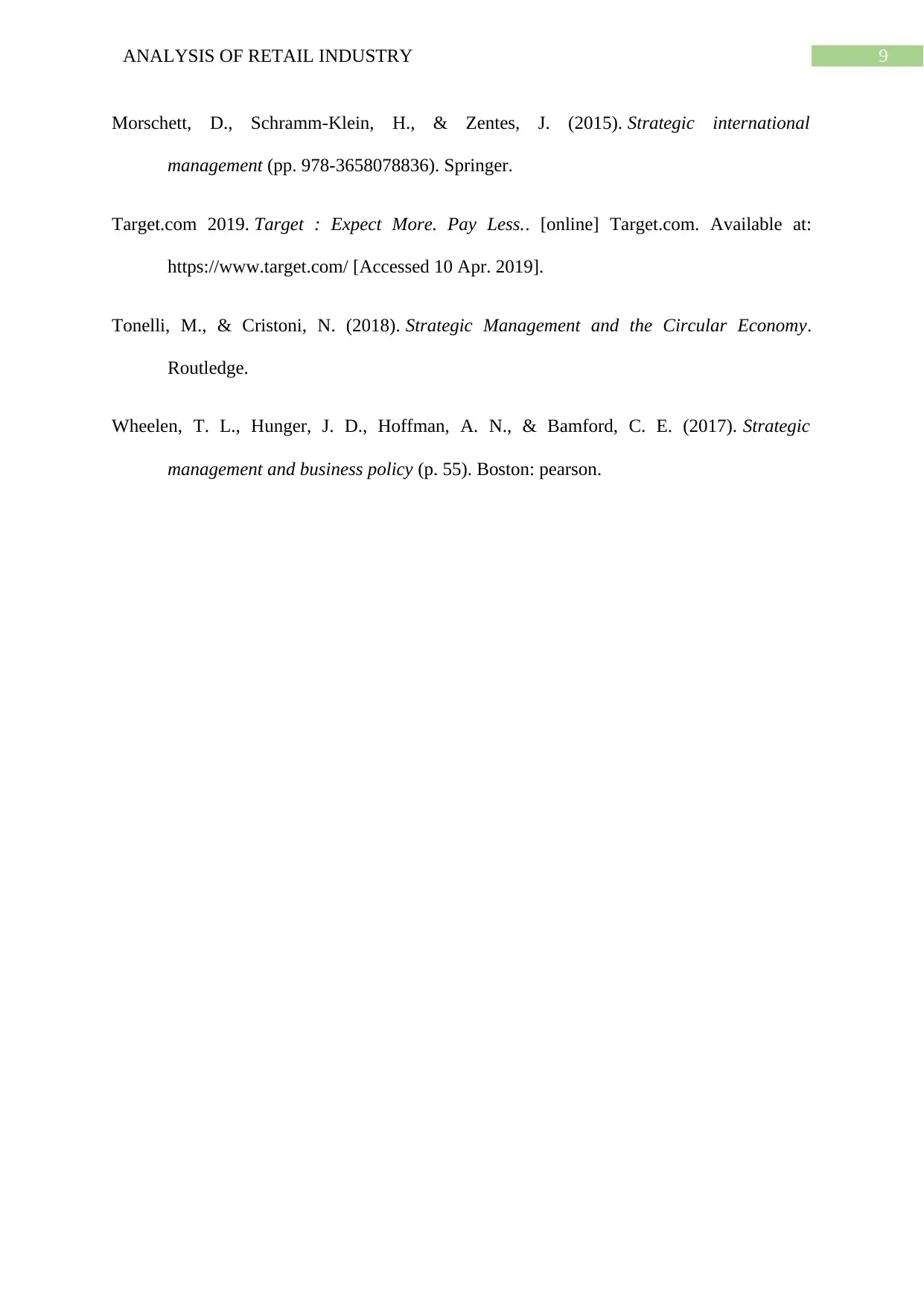
9ANALYSIS OF RETAIL INDUSTRY
Morschett, D., Schramm-Klein, H., & Zentes, J. (2015). Strategic international
management (pp. 978-3658078836). Springer.
Target.com 2019. Target : Expect More. Pay Less.. [online] Target.com. Available at:
https://www.target.com/ [Accessed 10 Apr. 2019].
Tonelli, M., & Cristoni, N. (2018). Strategic Management and the Circular Economy.
Routledge.
Wheelen, T. L., Hunger, J. D., Hoffman, A. N., & Bamford, C. E. (2017). Strategic
management and business policy (p. 55). Boston: pearson.
Morschett, D., Schramm-Klein, H., & Zentes, J. (2015). Strategic international
management (pp. 978-3658078836). Springer.
Target.com 2019. Target : Expect More. Pay Less.. [online] Target.com. Available at:
https://www.target.com/ [Accessed 10 Apr. 2019].
Tonelli, M., & Cristoni, N. (2018). Strategic Management and the Circular Economy.
Routledge.
Wheelen, T. L., Hunger, J. D., Hoffman, A. N., & Bamford, C. E. (2017). Strategic
management and business policy (p. 55). Boston: pearson.
1 out of 10
Related Documents
Your All-in-One AI-Powered Toolkit for Academic Success.
+13062052269
info@desklib.com
Available 24*7 on WhatsApp / Email
![[object Object]](/_next/static/media/star-bottom.7253800d.svg)
Unlock your academic potential
Copyright © 2020–2025 A2Z Services. All Rights Reserved. Developed and managed by ZUCOL.





